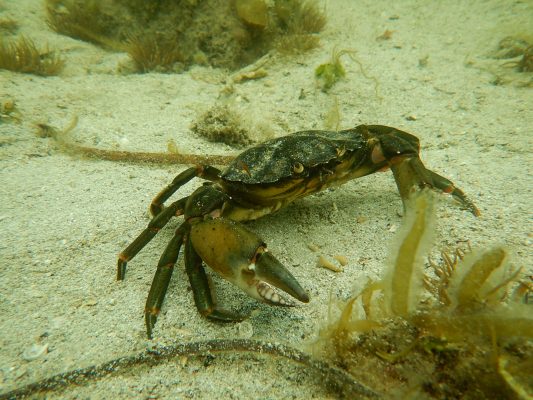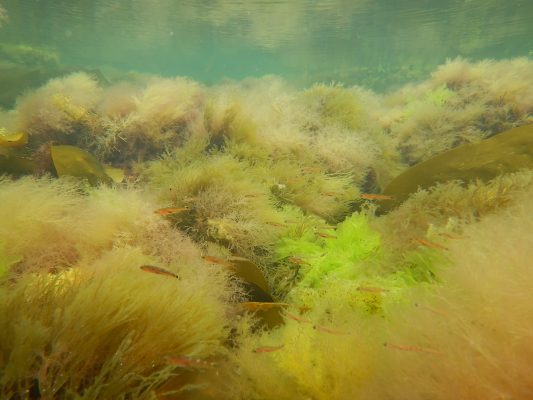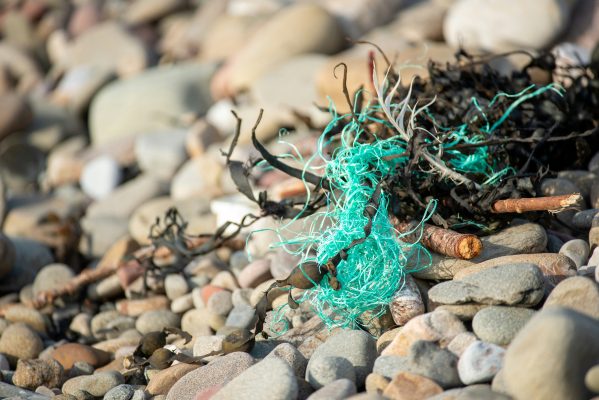Published: March 14th 2024
Author: Grace Carr, IWT Marine Advocacy Officer.
Here we look at the recently passed EU Nature Restoration Law (NRL) and what it means for life in the ocean. In this blog we look at the marine targets within the NRL. A hard campaign was fought to ensure the NRL was passed however, some elements have become watered down by those in opposition to it. Below we analyse whether those elements that made it into the final law are a good or bad result overall.
On the 27th February 2024 the EU Nature Restoration Law was passed by the EU Parliament. This law was first proposed by the European Commission in 2022 to restore 20% of EU land and 20% of EU seas by 2030. The Birds and Habitats Directives came into place around 30 years ago to protect vulnerable ecosystems and species but with over 80% of EU habitats in bad ecological condition, unfortunately what we’ve been doing so far hasn’t worked. It is now not enough to simply protect areas, we must also put in place measures to restore ecosystems back to their natural state.

The law has been extremely contentious since it was first proposed. There has been a great deal of misinformation spread on the law with the goal of scaremongering the public, particularly farmers and land owners. However, even with a targeted attempt to derail the law, over 1.1 million EU citizens signed a petition supporting the law and sent letters to their representatives. Ireland had the 3rd highest number of signatures per capita within the EU and we’d like to thank everyone who took the time to support the #RestoreNature campaign.
Agricultural targets are what the majority of the debate was over, but not much has been said about the marine and freshwater targets. Some very exciting and ambitious amendments made it through for the marine space. These provisions are going to be very important when it comes to managing Marine Protected Areas.
The NRL splits marine habitats into seven groups. Areas that are within Natura 2000 sites,Special Areas of Conservation (SACs) and Special Protection Areas (SPAs) will be prioritised up until 2030.
These seven marine habitat groups are;
Seagrass beds
Macroalgal forests
Shellfish beds
Maerl beds
Sponge, coral and coralligenous beds
Vents and seeps
Soft sediments (above 1000m of depth)
For groups 1 – 6, restoration measures must be in place on at least 30% of the areas not in good condition by 2030. This will increase to at least 60% by 2040 and at least 90% by 2050 of the area of each group.
Group 7, Soft sediments (above 1000m of depth), is considered a widespread ecosystem as it covers more than 3% of a Member States territory and therefore it will be subject to a lower threshold to be determined.
Member states have two years to draft their national restoration plans and within these they must quantify what percentage of soft sediments above 1000m are not in good condition.

Member states must also put in place measures to re-establish the habitat types (1-6) in areas where they have been lost. This is with the aim to reach their favourable reference area which must take into account records of historical distribution of the habitats and the projected changes which are expected due to the changes in environmental conditions due to climate change.
There is also a list of species included in the law and member states must put restoration measures in place to ensure the habitats these species are found in are improved, in addition to the previously mentioned thresholds. This includes reestablishing them and enhancing connectivity. The text states that restoration measures must have ecological coherence between habitat types and take into account the specific ecological requirements of the species that occur within them.
Many of these points are a good result for marine ecosystems. Ensuring that Member States quantify the percentage of soft sediments above 1000m which are not in good condition within their national restoration plans is a good result. However, these habitats having a lower restoration threshold then others is not as ambitious as we would have liked.
Member states must ensure that by 2030 the latest, the condition is known for at least 50% of the area of habitat types 1-6. By 2040, 100% should be known. For group 7, 50% should be known by 2040 and 100% by 2050.
A problem which is faced not only in the EU, but worldwide, is the lack of scientific data on natural ecosystems. This lack of data has allowed for the degradation of our natural world to occur with the reasoning being, well we don’t know if it will cause any damage, so let’s carry on with business as usual.
While the precautionary principle should be applied to these situations, it is more often than not ignored. Having it written within the law that data collection on habitats must be conducted and included within Member States national restoration plans is a good result for nature. It will help ensure further progression in conservation, not only through the NRL, but through other environmental and climate legislation.
Many Non-Governmental organisations (NGOs), including Fair Seas partner the Irish Wildlife Trust, fought hard to ensure that a provision stating that restored areas must remain in good ecological condition and not deteriorate was included.
In the end, this was included in the final text, however, the language used was watered down. The final wording states that ‘Member States shall put in measures which shall aim to ensure that areas which have reached good environmental condition, do not significantly deteriorate’. This watered-down wording allows for some deterioration to occur within areas and also allows for the success of measures to be more effort based rather than results based.
Another important point to make is that the non fulfilment of restoration targets is justified if it is caused by a plan or project which has overriding public interest or is authorised within the habitats directives. This means that plans such as renewable energy developments can still occur within protected areas and restored areas, thereby disturbing the habitats found there. It also states that Member States may exclude areas for restoration which are used for activities with the sole purpose of national defence.
Ensuring that once an area is restored that it remains in good ecological condition is not only best for the environment, but also best for the economy. Investing in restoration measures in areas and then allowing those areas to deteriorate over time doesn’t make a lot of sense.
We hope that Member States will ensure that this doesn’t happen even though the law allows for some deterioration. We would also have preferred the law to ensure that results were more important than just efforts as this can leave loopholes for Member States to pass on accountability.
Offshore Renewable Energy (ORE) developments are also exempt from adhering to measures within areas of restoration. We hope that Member States will take into account the importance of biodiversity in the fight against climate change and only have co-location of ORE developments and ecologically important restoration areas as a very last resort.
Member states will have 2 years to put together their national restoration plans. Within these two years they must carry out the necessary preparatory monitoring and research needed to identify measures that are needed to meet the targets.They must also make sure to take into account the latest scientific evidence and decide on areas which are most suitable for the reestablishing habitats in view of the projected environmental changes due to climate change.
Plans for member states to reach their 2030 renewable energy targets should be mapped in coordination with nature restoration plans, as to avoid conflict between the two objectives.
Public participation will be a very necessary component while drafting the national restoration plans. Member states should promote a fair and cross- society approach in the preparation of their national plans. We plan to work closely with Government and civil servants to ensure a strong and ambitious plan is achieved. We need a plan which will not only restore our marine ecosystems but also ensure an inclusive and just transition for all involved.
The NRL does not make it an obligation for Member States to redirect funding under the Common Fisheries Policy or other fisheries funding programmes under the multiannual financial framework 2021-2027.
Private and public schemes to support implementation of restoration measures should be included within the national restoration plans. The Commission will have 12 months to present a report assessing funding gaps and where appropriate have proposals for adequate measures, including financial measures to address the gaps identified without prejudging what will be included in the next multiannual financial framework after 2027. Advocating for appropriate funding for restoration measures as well as a just transition will be vital for the success of the Nature Restoration Law.

There is a specific article within the law which is aimed at the coordination of restoration measures across Member States by utilising the tools provided in the Common Fisheries Policy.
EU vessels have the right to fish in other EU members’ marine areas, however, if this area is important ecologically then conservation measures should be put in place. These measures are called Joint Recommendations under the COmmon Fisheries Policy and they are decided between the Member States involved.
In the past decade there have been very few Joint Recommendations submitted by Member States. The NRL asks that estimated timelines for consultation and submission of Joint Recommendations are included within their National Restoration Plans. They must take into account the deadlines for the restoration thresholds and be submitted no later than 18 months before the respective target date. If this date is not reached then the Commission may step in using the tools provided within the Common FIsheries Policy.
This is a big win for marine conservation. Coordination across Member States in marine conservation has been poor in the previous decades, but this law now sets in place timelines for conservation measures to be put in place in shared waters. It’s important to acknowledge that industries which have no emotional or cultural connection to an area and are there purely for short sighted economic gain, should not obstruct a nation’s efforts to protect and restore their marine environment. We have high hopes that this part of the NRL will create better management across our fisheries sector.
One final step must happen where the EU Council signs off on the law. This should happen in April and is usually just a formality. Once this happens the drafting of restoration plans can begin. So while the Nature Restoration Law is not as ambitious as the initial proposal back in 2022, it is still a significant step forward in conservation. There are parts which we wish were stronger but throughout the negotiations compromises had to be made to get the law over the line.
This is a law which will not only help nature, but also help in the fight against climate change. These twin crises are two sides of the same coin and must be acknowledged and worked on together. The socioeconomic benefits for people will also carry on for generations. Ensuring healthy seas helps ensure sustainable jobs and vibrant local communities far into the future.
With this new EU legislation passed, it is time that our government puts in place our National Marine Protected Area (MPA) legislation. Both laws will complement each other and ensure better management of our protected areas.
There is no time to lose. Work must begin on Ireland’s National Restoration Plans and strong MPA legislation needs to be published by government so that new MPAs can be taken into account while drafting the plan.